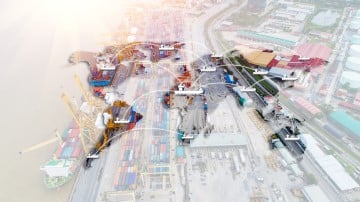Transport Optimisation
Logistics Consultancy » Transport Optimisation
What is Transport Optimisation
Transport optimisation is the review and improvement of the transport infrastructure, fleet, costs, and ways of working within a logistics operation. Transport optimisation finds ways to reduce the operating costs to make a network more efficient and while also meeting the service expectations of the customer. This often depends on balancing the goals between cost and service to put the right solution in place.
Transport optimisation projects are different to logistics network design in that the core focus of is on the transport function rather than the number, sizing and location of warehousing facilities across a distribution network. Although there can be some degree of overlap, transportation projects look more in depth at the infrastructure, scheduling, collaboration with customers and suppliers, vehicle fleet and software solutions of the transport function.
Advantages of Optimising Transport Operations
Transport activities can account for over half of all logistics costs and customer expectations for timely delivery are ever-increasing. There are many advantages that can be achieved through the optimisation of transport operations:
- Lower transport and logistics costs
- Improved service and customer retention
- Decreased carbon footprint by reducing transport miles
- Increased fleet utilisation
- Greater collaboration with customers and suppliers
How BoxLogic Can Help
BoxLogic can help drive efficiencies and service improvements within your transport operations by developing new solutions to address your specific needs, some of which are outlined below.
Project Stage | How Can BoxLogic Help |
|---|---|
Market entry or exit | Evaluate the available options to develop capable transport solutions as a business moves into new or withdraws from geographic territories whether they be regional, international, or continental. |
Review transport route schedules | Review existing transport schedules to create optimised order and delivery frequencies or routing plans based on the current, or an optimised, vehicle fleet mix. |
Scale transport capacity | Assess a range of options to develop a new transport solution that meets the requirements of growing or contracting throughput volumes. |
Review of transport infrastructure | Review the benefits of opening, closing, or moving transport infrastructure, which might include cross docking facilities, to support delivery service and cost optimisation as contracts or leases expire. |
Changing profile of customers | Evaluate the changing transport requirements that arise from a change in customer profile. A growing mix of larger customers may necessitate change in transport activities from vehicle fleet to order frequency and more. |
Drive service improvements | Identify feasible solutions that can drive improvements in service by looking at a range of areas including order and delivery schedules, inhouse versus outsourced transport, carrier selection etc. |
Deploy technology solutions | Review the processes, costs, and benefits of deploying technological solutions to manage route planning, carrier selection, vehicle deployment. This can involve the design, selection, or completion of a business case for a Transport Management System (TMS) or Carrier Management System. |
Customer transport profitability | Analysis of the cost-to-serve individual customer accounts to understand where certain customers negatively impact profitability along with recommendations of potential solutions. |
Review of transport fleet | Review of the current and future transport fleet requirements to identify the gaps between the existing capabilities within the fleet. |
Our Process
BoxLogic combine extensive experience in developing logistics solutions with our in-house developed modelling tools and trusted software solutions to visualise and validate our modelling outputs. Each project will differ according to the specific objectives, but a typical approach would be as follows:
We develop a strong working understanding of your transport operations, service requirements and performance by facilitating a kick-off workshop and interviewing key stakeholders to enhance our understanding of the project requirements.
We analyse representative data sets to understand current operational flows and produce visualisations of the current transport flows to illustrate how they work and where the opportunities lie. These flows are overlaid with growth projections to create a ‘planning base’. This is used as a key input to the option modelling phase.
Our consultants agree a shortlist of feasible options with the client project team. We then create bespoke models to evaluate the financial and service level implications of each scenario. Sensitivity analysis is produced to test each option under a range of scenarios to ascertain its robustness. A preferred solution is then agreed for further development.
We work with you to further develop the preferred solution into an end-to-end solution with a road map for transitioning to the future state network. We also support the building of a business case for board approval.
Case Study
Find out how BoxLogic helped a leading joinery distributor to optimise its transport function through the design of its rapid replenishment cross dock network.
Challenge
The client was looking to understand the optimal number and location of cross-docking centres (XDC) to support the fulfilment of its next day delivery service to its 800+ UK locations. The requirement followed on from a wider strategic network study, also conducted by BoxLogic.
Project Approach
- Analysed the network volumes and transport requirements between the businesses national distribution centres (NDC) and the 800+ customer locations across the UK. This included the costs of fulfilment based on results from a trial of the solution to create the assumptions to be used as modelling inputs.
- Created a bespoke model to consider the fixed and variable costs of trunking, delivery, labour, and property for each XDC location. The model used solver functionality to evaluate a much greater combination of modelling scenarios to optimise based on the cost, service and capacities within the network.
- Evaluated the optimal network for a range of XDC quantities, initially based on greenfield locations and then on a set of known locations based on the clients discussions with 3PL partners
- Made recommendations based on modelling outputs detailing the optimal number of cross-dock facilities, their location and how the network should develop as the business grows the quantity of customer locations
Results
BoxLogic provided the client with clear recommendations as to the preferred solution that were taken forward into the overall programme of implementation for the wider network rollout.
Why Work With BoxLogic
Our team of dedicated transport consultants are well placed to help you on your next transport optimisation project for several reasons.
- All BoxLogic recommendations are underpinned with rigorous analysis and modelling to give confidence in our work
- Expert consultant team with the right blend of strategic and operational experience so that we can be pragmatic and innovative in our recommendations
- We use bespoke modelling tools rather than ‘black box’ software so that we can fully explain and interrogate our output
- Excellent background of delivering similar projects for businesses of all sizes across a wide range of industries
- Capability to support the from network configuration to transport optimisation
GET IN TOUCH TODAY
Complete the form and one of our skilled consulting team will be in touch to discuss your warehouse and logistics project today.
Alternatively, give us a call or send an email.
- +44 (0) 118 309 4030
- enquiries@box-logic.co.uk
Frequently Asked Questions
Transport optimisation is the delivery of service and efficiency improvements within the transport function. A project would start with analysis of the current state and move to an evaluation of a range of options that might include the deployment of software, implementation of new route and delivery schedules, opening or closing of transport infrastructure, a change in the fleet mix, amongst other potential solutions. The project recommendations then need to be implemented.
Transport can be optimised in the supply chain in a variety of ways. These include selecting more appropriate transport carriers, using alternative modes of freight, changing the order or delivery frequency, deploying software to manage the routing process, investing in a more efficient or more appropriate fleet mix, as well as updating the transport route schedules or opening new infrastructure to support the transit.
The objective is to find the right blend of transport cost and service provision to customers. This happens through gathering a thorough understanding of the existing transport flows and evaluating the benefit of different solutions based on the customer’s specific requirements.
The key KPIs in transport optimisation projects is the overall transport costs and the average lead time to customers. The shorter the lead-time, the greater the benefits that can be provided to customers whilst lower costs increase profitability. A common goal of transport optimisation projects is to find the lowest cost solution for a given service level.
Other metrics might also be important in specific operations. These include vehicle utilisation (the percentage of available hours a vehicle is in use), the number of miles travelled, the amount of carbon emitted, etc. It is important to find the right balance between service and cost. A sole target of improving service will significantly add to cost while focusing solely on cost could significantly reduce service and damage customer retention.




